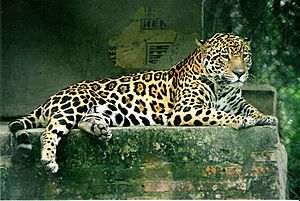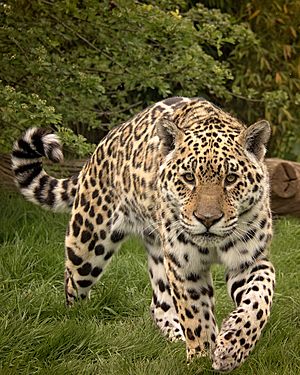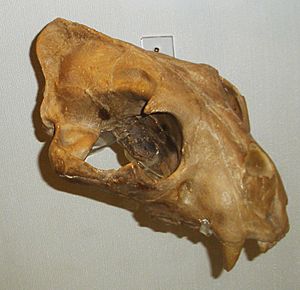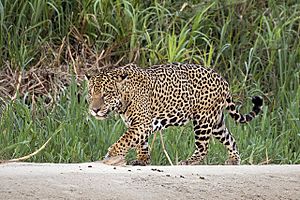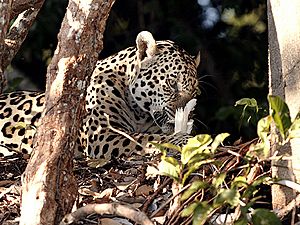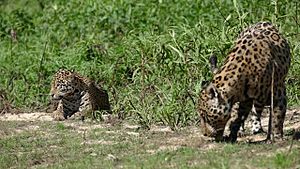Jaguar facts for kids
Quick facts for kids Jaguar |
|
|---|---|
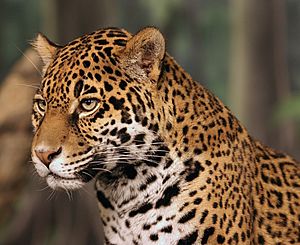 |
|
| A jaguar at the Milwaukee County Zoological Gardens | |
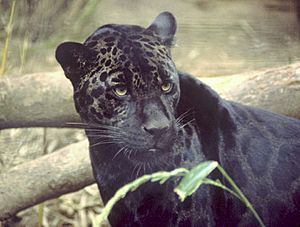 |
|
| A "black panther" jaguar | |
| Conservation status | |
| Scientific classification | |
| Kingdom: | |
| Phylum: | |
| Class: | |
| Order: | |
| Family: | |
| Genus: | |
| Binomial name | |
| Panthera onca Linnaeus, 1758
|
|
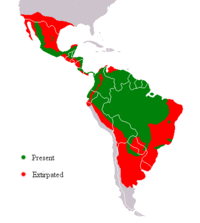 |
|
| Jaguar range | |
The jaguar is a large wild cat. It is the only type of Panthera cat found naturally in the Americas. Jaguars live from the Southwestern United States and Mexico down through much of Central America. They also live across a large part of South America. While a few jaguars are now seen in the western United States, most were gone from there by the early 1900s.
The jaguar is the biggest cat in the Americas. It is the third largest cat in the world, after the tiger and the lion. This spotted cat looks a lot like a leopard, but it is usually bigger and stronger. Jaguars like to swim and often live alone. They are skilled hunters that stalk their prey and then ambush it. As a keystone species, jaguars help keep their ecosystems healthy. They do this by controlling the number of animals they hunt.
People sometimes kill jaguars, especially when the cats cause problems for farmers. Even though their numbers have gone down, jaguars still live in a large area. Long ago, before Europeans came to the Americas, the jaguar was a symbol of power. Many ancient cultures, like the Chavín culture in the Andes, saw the jaguar as a very important animal.
Contents
What's in a Name?
The word "jaguar" might come from a word in the Tupi-Guarani language. This word, yaguara, means 'wild beast that catches its prey with a jump'. In some places, like Guyana, local people call it jaguareté.
The word "panther" comes from the ancient Greek word pánthēr.
Appearance
The jaguar is a strong, muscular animal. It is the largest cat in the Americas. Its fur is usually yellow-brown, but it can also be reddish-brown. The belly area is white. The fur has special spots called rosettes. These spots help the jaguar hide in the forest light. Each jaguar has unique spots and shapes. Jaguars living in thick forests are often darker and smaller than those in open areas.
Jaguars stand about 63 to 76 centimeters (25 to 30 inches) tall at the shoulder. Compared to a leopard, a jaguar is bigger and heavier. Its short, strong legs help it climb, crawl, and swim well. Jaguars have a very powerful bite. They can even bite through the tough shells of animals like caimans, crocodiles, and turtles.
Even though jaguars look like leopards, they are sturdier. You can tell them apart by their rosettes. A jaguar's rosettes are larger, fewer, and usually darker. They have thicker lines and small spots in the middle, which leopards do not have. Jaguars also have rounder heads and shorter, stronger legs than leopards.
Evolution of the Jaguar
Scientists believe that the group of cats called Panthera, which includes jaguars, started millions of years ago. Some studies suggest that jaguars are closely related to lions.
It seems that the jaguar's ancestors came from Africa. They then spread to Asia about 1.95 to 1.77 million years ago. The jaguars we see today might have come from a species called Panthera gombaszoegensis. This ancient cat likely crossed into the Americas using a land bridge that once connected Asia and North America. Fossils of modern jaguars have been found in North America that are over 850,000 years old.
Studies of jaguar DNA show that today's jaguars developed in northern South America. This happened between 510,000 and 280,000 years ago. From there, they moved back into North and Central America.
Habitat
Today, jaguars live from Mexico all the way to South America. This includes a lot of the Amazon region in Brazil. Jaguars are excellent swimmers and climbers. They often like to live near rivers, in swamps, and in thick forests. These places offer good cover for them to hunt.
Jaguars used to live as far north as the southwestern United States. The last wild jaguar in the U.S. died around 1960. However, some jaguars are now moving north again from Mexico.
In the early 1900s, jaguars lived as far north as the Grand Canyon. They were even found as far west as Monterey in California. The jaguar is now a protected animal in the United States. This means it is illegal to hunt them for their fur. People have also stopped wearing fur coats made from spotted cats.
Behavior and Ecology
Jaguars are mostly active at night and during twilight (dawn and dusk). But in some dense forests like the Amazon rainforest, they can be active during the day. Jaguars are very good swimmers. They often play and hunt in the water, even more than tigers do. They have been seen swimming between islands and the shore. Jaguars can also climb trees well, but they do it less often than cougars.
Ecological Role
An adult jaguar is an apex predator. This means it is at the very top of the food chain. No other animal hunts the jaguar in the wild. Jaguars are also called a keystone species. This is because they help control the number of plant-eating animals. By doing this, they keep the forest healthy and balanced.
Jaguars often live in the same areas as cougars. In Mexico, both cats hunt white-tailed deer. In South America, jaguars are larger than cougars. They tend to hunt bigger animals, usually over 22 kilograms (48 pounds). Cougars usually hunt smaller prey, which is why they are smaller.
Diet
Like all cats, jaguars only eat meat. They are opportunistic hunters, meaning they will eat almost anything they can catch. Their diet includes at least 87 different kinds of animals. When hunting, they try to get very close to their prey without being seen. Then, the jaguar suddenly jumps and tackles the animal. It then takes its prey to a safe spot to eat.
Jaguars are stalk-and-ambush hunters. They walk slowly along forest paths, listening for prey. Once they find an animal, they sneak up on it. They usually attack from a hidden spot, like from behind a bush. Their ambush skills are amazing. Jaguars can even leap into the water to catch prey. They are strong enough to carry a large animal, like a cow, up a tree to keep it safe from floods.
Sometimes, jaguars will wait by the water and hit it with their tail. This attracts fish. When the fish come closer, the jaguar quickly swipes them out of the water with its paw.
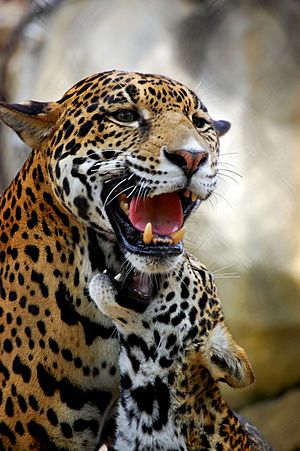
Jaguars are often described as active at night. But they are more active around dawn and dusk. Both male and female jaguars hunt. Males travel further each day because they have larger territories. Jaguars are quite energetic. They spend about 50-60 percent of their time being active. It is hard to see or study jaguars because they are shy and live in hard-to-reach places.
Social Activity
Jaguars usually live alone, except for mothers with their cubs. Sometimes, groups of a male, female, and cubs are seen together. A mother jaguar will stay with her cubs.
Jaguars use scratch marks, urine, and feces to mark their territory. The size of their territory depends on how much forest is left and how many people live nearby. Female jaguars have territories that can range from 15.3 square kilometers (5.9 square miles) to 233.5 square kilometers (90.2 square miles). Male jaguars have much larger territories, from 25 square kilometers (9.7 square miles) to over 800 square kilometers (300 square miles).
Fights between male jaguars are rare. They usually try to avoid each other. Jaguars communicate over long distances by roaring or grunting. This sound is often described as "hoarse." When jaguars greet each other, or when a mother comforts her cubs, they make a soft, low sound called "chuffing." Cubs make sounds like bleating and gurgling.
Reproduction and Life Cycle
Female jaguars raise their cubs alone. Pregnancy lasts about 93 to 105 days. Females usually give birth to two cubs, but they can have up to four. The cubs are born blind and open their eyes after two weeks. They stop drinking milk at three months old. Cubs stay in their den for six months before they start going on hunts with their mother. They will stay with their mother for one to two years. After that, they leave to find their own territory. Young males often wander around until they can claim a territory.
In the wild, jaguars usually live for about 12 to 15 years. In zoos, they can live much longer, up to 23 years. This makes them one of the longest-living cats.
Images for kids
See also
 In Spanish: Jaguar para niños
In Spanish: Jaguar para niños




